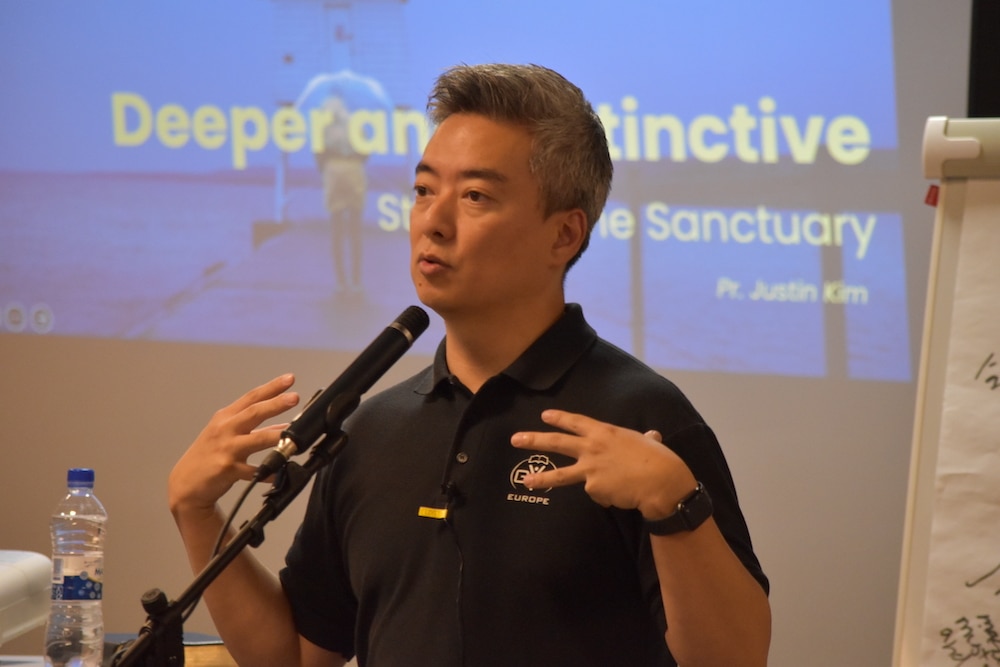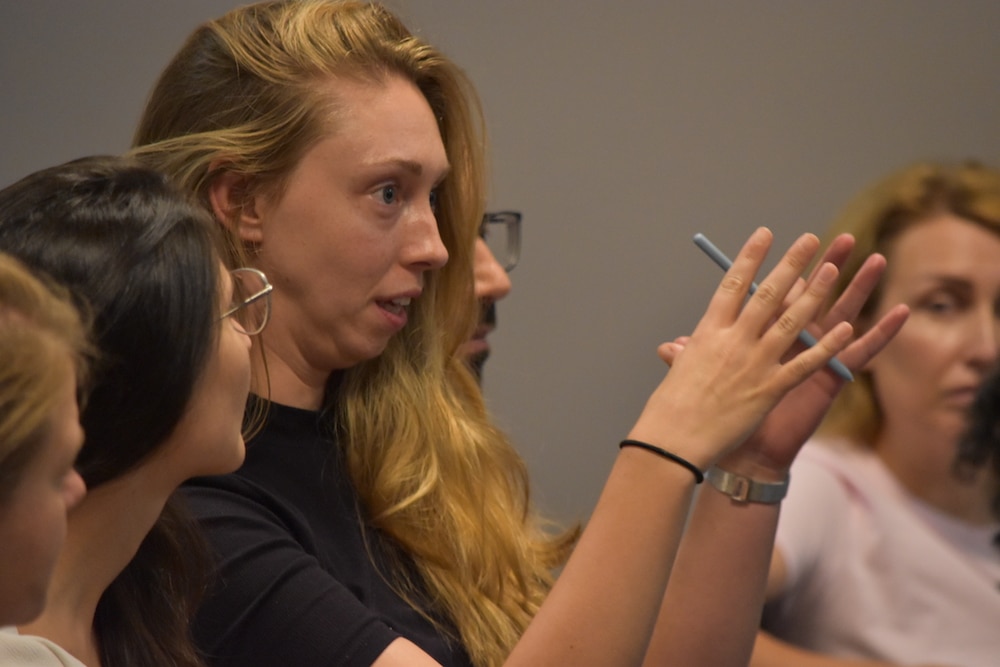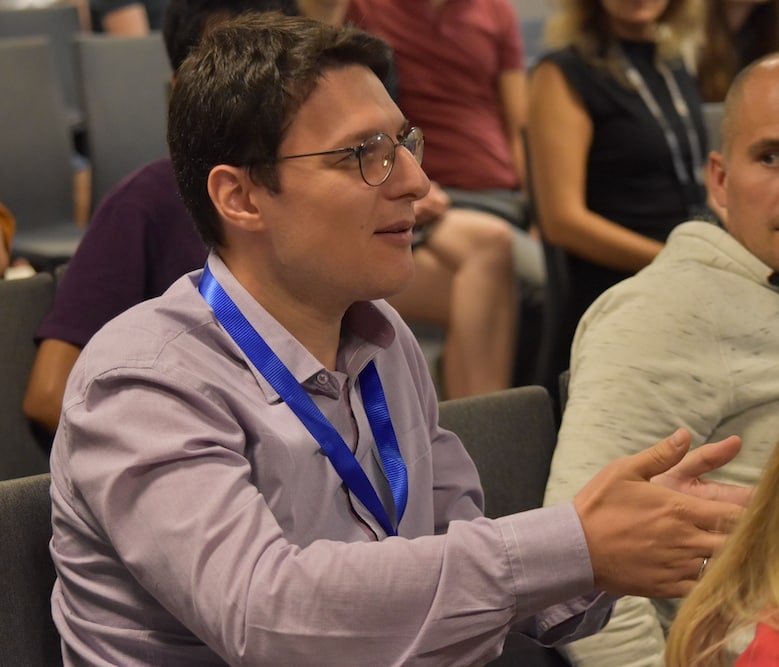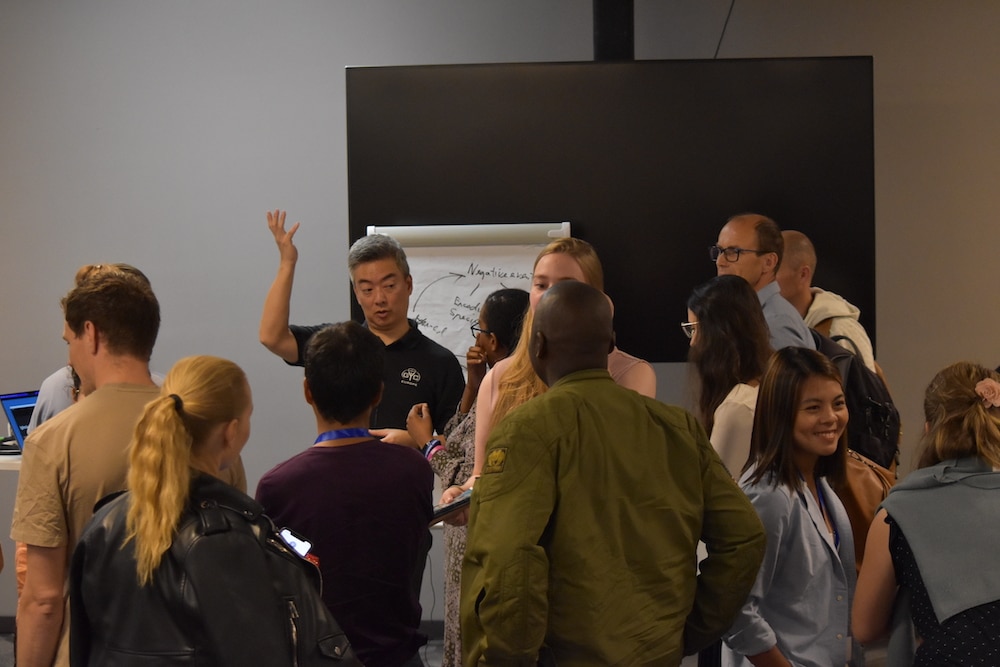
“The purpose of this presentation is to overwhelm you,” Adventist Review and Adventist World executive editor Justin Kim told dozens of young people who attended one of his workshops at the Generation. Youth. Christ. (GYC) Europe convention in Riga, Latvia, in August. “It is to get you to say, ‘Wow! I need to go study the Bible by myself!’ ”
Kim’s presentation, “Deeper and Distinctive: Studying the Sanctuary,” drew young Seventh-day Adventists from across the European continent to learn, ask, and reflect.
“This is not an easy topic,” Kim conceded, while emphasizing its importance. “Many Seventh-day Adventist doctrines are not unique to us. But the sanctuary doctrine as we are going to discuss it today is unique to us.”
In the following hour, Kim explained what Adventists are talking about when they discuss the doctrine of the sanctuary, why this doctrine is important, and how we can start going deeper in its study.
Dwelling with Us
As a first point, Kim said, it is key to remember that “the heart of all this doctrine, teaching, and instruction … is God’s desire to dwell — to hang out — with humanity. We need to preserve and capture that notion,” he said.
That understanding was key to the tabernacle, he added. “Externally, there was a tent, but inside, there was the shekinah glory — God’s presence,” Kim said. The same applies to Jesus, who had a human body but was God. “It is a motif that you can find throughout Scriptures,” he said.
The problem, Kim reminded his audience, is that God is holy, and we are sinners. “How could we ever hang out? We’d be obliterated.” It is then that the doctrine of the sanctuary introduces us to the doctrine of salvation.
In the Bible, Daniel 8:14 is the foundation of the Adventist identity, which tells us that the heavenly sanctuary would be cleansed, Kim reminded the young people. “But the golden question is, What is Jesus doing right now?” he said. “The answer to that question is the present truth we all ought to preach right now.”



The Sanctuary as a Framework
The sanctuary is a framework that can be used in various ways, Kim said. One way is focusing on an eschatological timeline. The sanctuary also presents anthropological parallels. “The Holy Place is the mental concerns, and the Most Holy Place is the spiritual concern,” he explained.
Then there are those who explain the sanctuary by emphasizing its soteriology, or the doctrine of salvation, Kim shared. “The courtyard represents justification, the Holy Place represents sanctification, and the Most Holy Place represents glorification.”
Others focus on its ecclesiological significance. Protestants, for instance, emphasize “the courtyard ministry,” he said. “Jesus died for you; He forgave you from all your sins; amen.” Sanctification, on the other hand, focuses on the process toward salvation. “The community that really thrives on sanctification is Roman Catholicism, even if it’s not biblical sanctification,” Kim explained. “ ‘Once you receive those droplets of God’s grace through the sacraments, you can become holy,’ ” they would say.
There are also some who only focus on the Most Holy Place — on judgment. “Everyone is doomed to destruction except for them,” Kim said. “They are the holy ones, and they are just waiting for Jesus to come. They are not Adventists, even if some call themselves so,” he added.
Correctly understanding the whole doctrine of the sanctuary can provide balance, Kim said. “For those who come from an Evangelical tradition, you need more of the sanctification and glorification part,” he said. “Some of us, on the other hand, come from a very heavy sanctification background, with a strong focus on behavior. We need a justification experience.”
Other Approaches
A temporal approach to the sanctuary, on the other hand, focuses on the spring and fall festivals, as explained in Leviticus 23. In this analysis, the spring festivals point to when Jesus came for the first time — Passover at His death, and then Pentecost, when He was crowned. Fall festivals point to Jesus’ second coming — the trumpets, the Day of Atonement, and so forth, Kim explained. “Even using the calendar and time points to Jesus. That’s the cool thing about the sanctuary,” Kim said. “Space points to Jesus; time points to Jesus; even smells point to Jesus. All things point to Jesus, and it is our joy to find out what those things are.”
Yet another approach focuses on agricultural cycles that pointed to Jesus’ ministry, he explained. “Back then, they had the early rain, a summer drought, and then a latter rain — the fall rain,” he explained.
Rightly understood, everything points to Jesus. Kim quoted Ellen G. White, who wrote, “The significance of the Jewish economy is not yet fully comprehended. Truths vast and profound are shadowed forth in its rites and symbols. The gospel is the key that unlocks its mysteries. Through a knowledge of the plan of redemption, its truths are opened to the understanding. Far more than we do, it is our privilege to understand these wonderful themes” (Christ’s Object Lessons, p. 133).
The Sanctuary as a Map
Kim also explained that the book of Revelation is key to understanding the doctrine of the sanctuary better, because that book uses the sanctuary as a map. “The first time you arrive at a new place, you might feel lost,” Kim said. “But the longer you are there, you start finding your way around. In Revelation, the sanctuary is also like that. The first time you read about it, you might not understand where you are, but the more you read, it will show you your exact place, just like a map does.”
Kim also invited young people to think of the sanctuary as God’s house to apprehend the meaning of it various pieces of furniture and major parts and sections.
In Revelation, Jesus also appears in the middle of the candlesticks. “It shows that Jesus is our caring priest, because Jesus is in the midst of the seven churches,” Kim said. “If you are in a legalistic church, He’s still there; if you are in a persecuted church, He’s still there; even in the apostate church, God is in the midst there. There might be some horrible leaders out there, but Jesus is still into this.… It doesn’t matter what kind of Seventh-day Adventist Church you are from, Jesus is still in the midst of that church.”
The table of showbread shows that Jesus is our King of the covenant who defends His church. “Whenever His church is under attack on earth, Jesus is in heaven, in the air traffic control tower,” Kim said. “From heaven, He still is king, and He commends His angels and defends His church, and His church is never defeated here on earth.”
The altar of incense, on the other hand, represents that Jesus is our High Priest and that He answers all our prayer requests. “The altar of incense is like this big laptop kiosk, and all the prayers come to his laptop. They only come if they include the password, and the password is, ‘in Jesus’ name, Amen.’ He answers everyone, and He always achieves zero inbox messages at the end of the day,” Kim said.


What to Do about the Sanctuary
In Adventism, this belief of the sanctuary has been attacked from the inside, Kim reminded workshop attendees. He quoted Dudley Canright, a 19th-century Adventist pastor, who said, “Seventh-day Adventists makes everything turn upon their view of the sanctuary. It is vital. If they are wrong on this, their entire theory breaks down.” “I fully agree with this,” Kim said.
Thus, Kim emphasized, this realization should prompt us to study the sanctuary more. “This is the one field where we need to keep doing research and finding new light. Many theologians and scholars are doing it. What we need is now a movement of laypeople also studying the Bible,” Kim said.
After Kim’s one-hour presentation, workshop attendees had the opportunity to react. Many hands raised, as young people asked about resources, clarifications, and shared doubts and objections.
“Is this doctrine important for salvation?” a young woman asked Kim. “Don’t you think a person can find God, find Jesus, go through repentance, and be saved, without knowing anything about the sanctuary? I know it’s important, but, could it be that it has been overemphasized?”
Kim answered that there are people who have been lost by denying the doctrine of the sanctuary, but knowing the exact doctrine of the sanctuary doesn’t mean a person is saved.
At the same time, Kim emphasized again, it is a complicated topic, but it’s predicated on a relationship with Jesus. He explained, “Adventism started assuming everyone had a relationship with Jesus. So, if you say, just give me the bare minimum I need to be saved, it’s like telling my wife, ‘I love you, but just give me the minimum information possible. When is your birthday? OK, that’s all I want to know. I am not interested in knowing all the things you are doing.’”
Getting to know Jesus through the doctrine of the sanctuary is a process of going deeper, and it takes time and effort, Kim said. It is essential we understand this as we approach the topic. Otherwise, he said, “it’s like going to the street and telling people, ‘Do you want to know more about Jesus? Here’s the doctrine of the sanctuary!’ It doesn’t work that way.”
Kim reminded GYC Europe members that Adventism came from other Christian churches that already knew Jesus. “The first Adventists wanted a deeper and more complex understanding,” he said. “And by complex, I mean they asked, ‘What is Jesus doing right now? Why all these symbols and images in the Bible?’ And because they had a relationship, they felt they had to go deeper, toward a deeper experience.”
Against that background, the mistake a Seventh-day Adventist can make is to say, “Because I had that experience, I want you to have that experience without meeting Jesus first,” Kim said. “So, is this message for everyone? No! People need to meet Jesus first. But I believe through the sanctuary, they can understand Jesus better.”
Generation. Youth. Christ. (GYC) is a youth-led organization that supports the spiritual mission of the Seventh-day Adventist Church but is an independent supporting ministry not controlled by or legally affiliated with the church.